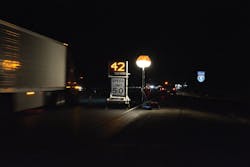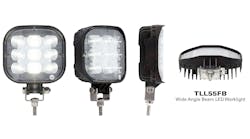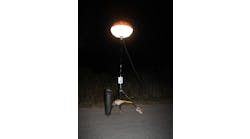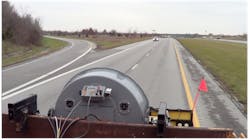It should go without saying that every state department of transportation prioritizes safety for its crews as well as for the traveling public when it comes to setting up work zones along any roadway, including making sure that motorists can clearly see where the work zone, crews and equipment are located.
Over the past few years, the Oregon Department of Transportation (ODOT) has conducted various research on a number of work-zone interventions, which are put in place to ensure road users are aware of the work zone, in order to determine how the presence of such devices may impact driver behavior. These have included placing any type of warning signs, radar-speed signs or a police presence in the vicinity of work zones along highways.
In these studies, ODOT researchers found that there is typically a reduction in motorist speeds as drivers approach work zones, particularly when they move closer to equipment such as a paver or milling machine. As such, one of the questions that came up as ODOT collaborated with Oregon State University (OSU) on these studies was whether or not placing temporary lighting throughout a work zone—which might include something like a light tower—would have an impact on the speeds of drivers passing by.
This question is particularly relevant for nighttime construction work, as work-zone visibility for motorists decreases at night, especially along roadways with limited to no street lighting. As nighttime construction work is fairly common due to its limited traffic impacts, the availability of sufficient lighting becomes a crucial component for roadway work zones.
Studying temporary lighting
ODOT partnered with faculty members at OSU to compile research on the “use of additional lighting for traffic control and speed reduction in work zones.” This was one of the research topics for a study selected by ODOT as part of its research program funded by the Federal Highway Administration (FHWA).
The proposal to research this topic came from OSU School of Civil Construction Engineering Professor John Gambatese, who has worked on a number of research projects with ODOT over the years. With assistance from OSU graduate student Ali Jafarnejad, Gambatese was the principal investigator on the project, overseeing and conducting the study on behalf of ODOT.
The main objective for ODOT’s research was to determine how much of an impact the presence of temporary lighting in a work zone would have on motorist speeds as they drove by. “We were looking at the impact of these lights, whether drivers change their habits in terms of speed,” Gambatese told Roads & Bridges. Some of the temporary lighting equipment typically used on ODOT work zones in this study included light towers (also called light plants), balloon lights and personal lighting that crew members could wear on their uniform.
Gambatese and Jafarnejad began with a literature review and documentation of current work-zone lighting systems, in order to better understand work-lighting practices as well as lighting terminology, specifications and performance. “And then we followed it up with some initial data gathering by going out to existing projects and measuring the amount of light that’s typical on a project,” Gambatese said. “We collected data in different spots where they had lighting attached to equipment, and went out there with the light meter to figure out how much lighting is emitted. Also, if they used a light on a tripod or a light plant, we would take some measurements just to get an idea of the amount of light available in different spots.”
In the next phase, the research team ventured out to a controlled site near the Corvallis Airport in Benton County to set up a test work zone with lighting equipment along a closed-off road with no traffic. “We did some measurements with the light in different situations and with the worker wearing a wearable light,” Gambatese said. “And then kind of assessing how they look at different distances—500 ft, 1,000 ft or 1,500 ft away.” The goal of this phase was to determine the level of visibility of a worker wearing a class 2 or class 3 vest with and without wearable lighting on the worker’s uniform. According to the final report, some of the results of these tests found that, for instance, from a distance of 500 ft away under a 2,000-watt light tower and the balloon light—with the worker wearing a class 2 vest and pants—the worker can be recognized. However, from 1,000 ft away or more under similar conditions, it is hard to identify that the worker is present.
After making some of their own observations at the test site, the OSU researchers followed up by assembling focus groups composed of ODOT employees and contractors to come to the test site to determine for themselves how well they could see a worker under different circumstances. “We had them rate the different situations in terms of ability to see the worker,” Gambatese said.
A radar-speed trailer with a balloon light on I-5 between Medford and Ashland in Oregon.
Observing live work zones
The next step in the research project was to assess the impacts of particular lighting strategies in a live work zone. The OSU team coordinated with ODOT to observe the use of the lighting systems in the work zones at night, the type of work being conducted and the vehicle speeds of passing motorists. “One night we would turn the light plant on and measure the speeds of the passing traffic,” Gambatese said. “And then the next night we would have the light plant turned off and also measure the speeds.”
The team compared data collected on vehicle speeds for nights with and without lighting after conducting tests implementing both the light plant and balloon lights. According to the final research report, the test results for each equipment piece were evaluated and compared based on a variety of factors that included ease of use, vehicle speed impacts, speed variability, worker visibility and productivity, and implementation cost. The team also compared data based on varying locations of the light equipment within the work zone.
Results
After collecting speed data from two case study projects that analyzed the speeds of motorists passing by live work zones under a variety of lighting conditions, the researchers drew some conclusions they did not necessarily expect to make. The team found that, in general, there was no difference in the mean speed of motorists passing by work zones with a light tower as compared to passing by a work zone with a balloon light. In addition to this, when speeds were compared between work zones with additional lighting and without it, vehicle speeds were determined to be slightly higher with the presence of temporary lighting.
“We did recognize there is better visibility in the work zone,” Gambatese said. “While there’s no difference between the light tower and the balloon light, if we put any type of light there, then we recognized slightly higher vehicle speeds because [motorists] can see the roadway better, perhaps—that’s our hypothesis.” According to the final report, the mean vehicle speed was found to be 1.8 to 5 mph greater when a light tower or balloon light was present in the work zone.
In addition to the findings regarding the temporary lighting structures, the researchers also concluded that there was no difference in mean vehicle speeds based on whether or not workers wore personal lighting in the work zones. “We think that the worker is more visible, but the drivers don’t necessarily change their speed with or without the lighting,” Gambatese said.
Class 3 high-visibility apparel used by ODOT crews for nighttime construction work.
Recommendations
Since one of the goals of this study was to determine how additional work-zone lighting might impact worker safety, recommendations for further study and implementation were made by the OSU research team in terms of how temporary lighting might mitigate safety risks for roadway crews.
Some of the recommendations consider crew members who may be operating away from the main work area by suggesting additional lighting follow those workers as they move away from the site. “The way it works for a mobile paving operation, at the back end you might have the density tech on his own on foot doing density measurements,” Gambatese said. “And that person often is in and out of their truck as they move along, so he’s on the roadway all by himself in the dark.” For the situation he described, Gambatese said he recommended that a portable light be provided for the density technician’s vehicle as well as personal lighting for when that worker is on foot. In conjunction with this issue, the researchers determined that the mobility of the lighting equipment is important, and that it is helpful to crews if the lighting is attached to the construction equipment, allowing the lighting to move with the work zone as needed.
Another recommendation took into consideration potential glare for motorists and equipment operators coming from the lighting equipment. The report conclusions suggested that when a light tower or any light is used in the work area, the light should be oriented in a way to prevent glare. “Too much lighting in terms of pervasive glare for drivers is a very big issue,” Gambatese noted. “If the light towers are used such that they are oriented toward the direction of oncoming traffic, that could be a problem.”
As worker safety for nighttime construction work is paramount for ODOT as well as for transportation departments across the country, this research highlights just how crucial proper lighting is for work zones at night in terms of making sure the work area and crews are visible to the traveling public. Additionally, Gambatese emphasized, work-zone lighting for workers to see what they are doing is equally vital for work-zone safety. “It’s important that there’s lighting for conducting the work itself, making sure there’s enough lighting so workers can do their job,” he said. “And balancing how much lighting there is for that versus lighting the work area for the drivers.”



